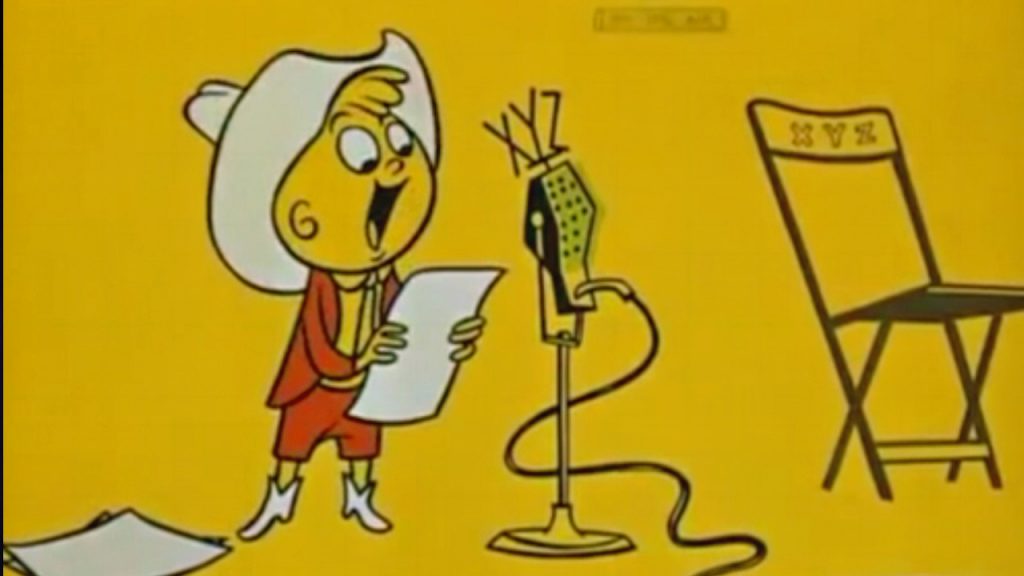Most people think of each classic commercial American animation studios as having their own distinctive sonic style. Warner Brothers had the postmodern, action-driven sound developed by Carl Stalling. MGM had the classically trained Scott Bradley pumping out modern, occasionally atonal scores. Even Disney, with its variety of composers, had a particular style based in middle-America nostalgia. But the music from UPA cartoons stands out from these and many other of its competitors precisely because it did not have a distinctive style. Part of this stems from the lack of a “house” composer. For example, upon a cursory study of the films in the DVD set UPA Jolly Frolics Collection, it emerges that no fewer than 16composers were used over the course of 38shorts, including Del Castillo, Gail Kubik, David Raskin, Hoyt Curtin, Ernest Gold, Phil Moore, George Bruns, Boris Kremenliev, Benjamin Lees, Dennis Farnon, Billy May, and Mel Leven, among others. Each had their own musical currency. Some of these composers worked on animation from other studios. George Bruns wrote music for Disney, for example, and Hoyt Curtin is perhaps best known for his work with Hanna-Barbera. Some, such as Gail Kubik (composer on Gerald McBoing Boing) focused more on their classical compositions. Still others, such as Phil Moore, were better known for their contributions to popular music. In part due to the disparities of backgrounds, the scores for these UPA films seem to have no connection to each other.

Where the connection lies is not in the actual sounds of their films, but in their fealty to UPA’s approach to animation. Like the shorts themselves, the expectation was not to create a familiar product (with a few exceptions, such as Mr. Magoo or the later Gerald McBoing Boing films), but rather, to create a specific mood and color to fit the story. Thus, each cartoon’s soundtrack focuses on matching the particular aesthetic of that specific short–whether or not it matches other cartoons from that director–or using that main character. Boris Kremenliev’s score for their adaptation of Edgar Allan Poe’s The Tell-Tale Heart (1953), for instance, compares favorably with the scores for the classic The Twilight Zone (1959-1964), using modern classical music approaches to paint the madness of the narrator, while the lack of sound effects (except at key moments such as the beating of the heart or dripping of the tea) add focus to the story. African-American Phil Moore essentially produces a jazz operetta for Rooty Toot Toot (1951), fitting nicely with the almost improvisatory look of the animation as well as the plot’s basis in song. The opening credits even start with the beginning of that song, helping to set the scene. Hoyt Curtin’s music for When Magoo Flew (1954), while not closely mapped to the action as Warner Brothers cartoons of the time were, still adds to the levity of the story, using a considerable amount of tuba to represent Mr. Magoo aurally. Each of these scores varies widely from each other, yet matches the accompanying film perfectly, helping to create a miniature piece of art that often pushed the boundaries of commercial animation.
Indeed, given the purposely different nature of the UPA films (especially those not in the Mr. Magoo series), having a house composer (or even similar-sounding scores for each cartoon) would not only seem anathema to the studio’s approach but would also tarnish the quality of many of these films. One of the hallmarks of the UPA studio was to bring each aspect of the film together into a cohesive stylistic unit. Therefore, working toward an overall unity of sound would have been at odds with the brilliant disparity of the studio’s output as a whole.
Lisa Scoggin completed her Ph.D. in Musicology at Boston University and received degrees from Oberlin College and the University of Wisconsin – Madison. She has presented papers internationally at various conferences, including the Music and the Moving Image conference, the Society for Cinema and Media Studies conference, and the Society for Animation Studies conference. She has taught at Boston University, St. Anselm College, and Tufts University, where she taught a course on music in American animated film. Her book on the music from the show Animaniacs is now available from Pendragon Press.
